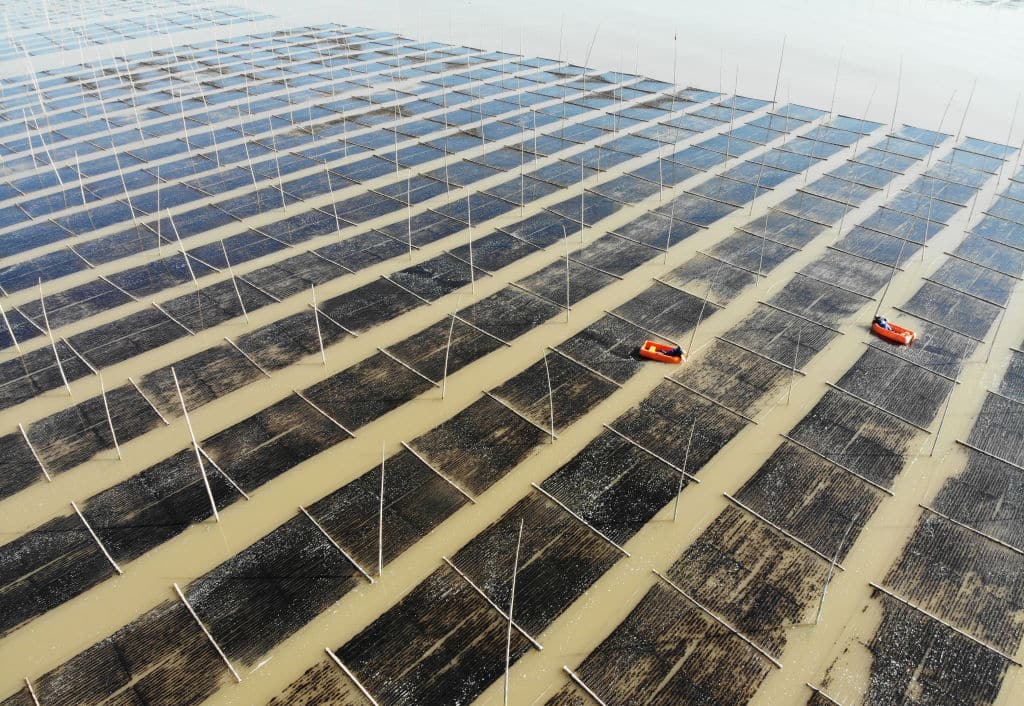Products You May Like
Aerial view of farmers working at a seaweed farm on November 24, 2021 in Taizhou. Jiang Youqing / VCG / Getty Images
 Why you can trust us
Why you can trust us
Founded in 2005 as an Ohio-based environmental newspaper, EcoWatch is a digital platform dedicated to publishing quality, science-based content on environmental issues, causes, and solutions.
In order to feed a global population that is expected to increase by more than two billion by 2050, we’re going to have to reconfigure our food system. Microalgae — single-celled photosynthetic microorganisms that live in both seawater and freshwater — could be the food of the future.
Microalgae are an excellent source of vitamins and packed with protein. Aquaculture cultivation of this nutrient-dense food in seawater along the coastlines of the Global South could contribute to an increase in food production of 50 percent and feed an estimated 10 billion people by 2050, according to a press release by the Cornell Chronicle.
A new paper, “Transforming the Future of Marine Aquaculture: A Circular Economy Approach,” published in the journal Oceanography, explores the possibility of growing microalgae to help provide humans’ projected future food demands while improving the sustainability of the world’s food supply.
Climate change, the degradation of the environment, finite areas of arable land and shortages of freshwater all limit the quantity of land-based agriculture the planet can support, the paper said.
“We have an opportunity to grow food that is highly nutritious, fast-growing, and we can do it in environments where we’re not competing for other uses,” said Professor Emeritus of Earth and Atmospheric Sciences at Cornell University Charles Greene, who was the senior author of the paper, in the press release. “And because we’re growing it in relatively enclosed and controlled facilities, we don’t have the same kind of environmental impacts.”
The researchers said growing algae in aquaculture facilities along the coast could be a solution to the limits being put on aquaculture of seaweed, shellfish and fish, as well as the already overfished wild populations.
According to predictions using a geographic information systems (GIS)-based model developed by Celina Scott-Buechler, a former graduate student at Cornell, the best places for onshore algae farms are the coastal regions, including deserts, of the Global South.
“Algae can actually become the breadbasket for the Global South,” said Greene in the press release. “In that narrow strip of land, we can produce more than all the protein that the world will need.”
Algae not only provides omega-3 fatty acids that can be found in fish, it also has minerals and amino acids that are often missing in vegetarian diets.
It also grows ten times faster than conventional crops and can be grown without wasting fertilizers, half of which can be lost in terrestrial farming through runoff and end up polluting water sources. The self-contained facilities where algae is grown means leftover nutrients can be reused.
Algae needs carbon dioxide to grow in aquaculture ponds, which can be a plus for the climate crisis.
“If we use algae in these long-lived structural materials, then we have the potential to be carbon negative, and part of the solution to climate change,” said Greene in the press release.
Gathering carbon dioxide is an expensive and inefficient endeavor, but experiments are being done with solar technologies to try and improve the process of capturing carbon from the air.
One major hurdle is pretty basic: will people accept algae as a part of their diets and for use in other contexts?
Algae can be added to plant-based meat alternatives that now rely on soy and pea, which aren’t as nutritious. Some of the researchers have found that hens who are given feed supplemented with algae lay eggs with triple the amount of omega-3 fatty acids.
“We believe in the potential of microalgae to reimagine how we eat,” said cofounder of We Are the New Farmers Jonas Guenther, as Grist reported.
Subscribe to get exclusive updates in our daily newsletter!
By signing up, you agree to the Terms of Use and Privacy Policy & to receive electronic communications from EcoWatch Media Group, which may include marketing promotions, advertisements and sponsored content.
